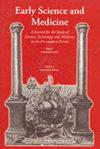复合体与学相的转化(约1200年)1500
IF 0.2
2区 哲学
Q3 HISTORY & PHILOSOPHY OF SCIENCE
引用次数: 0
摘要
这篇文章调查了面相话语中复杂的漫长故事,从盖伦的De complexionibus (De temperamentis)到15世纪Rolandus Scriptoris和Michele Savonarola的伟大面相手册。一路上,我们流连于各种面相学文本,最引人注目的是迈克尔·司各特、阿拉贡的威廉和约翰·布里丹对面相学话语的贡献。在13世纪,随着思想重要性的突飞猛进,新兴故事从缺乏复杂性走向无所不在。这种变化的推动者是自然哲学家和医生——可能是通过医学中介(最著名的是雷泽斯),他的文本在12世纪为拉丁读者所知;他们借用了这个术语,并将其融入到他们的文本中,现在他们的文本中包括了缺失的将面相符号与其含义联系起来的因果解释。各种肤色之间的区别,最值得注意的是渐次使用的肤色概念(大约1300年),在这一发展中发挥了关键作用,为面相判断提供了更稳定的基础。本文章由计算机程序翻译,如有差异,请以英文原文为准。
Complexio and the Transformation of Learned Physiognomy ca. 1200–ca. 1500
This article surveys the long story of complexio in physiognomic discourse, from Galen’s De complexionibus (De temperamentis ) to the great physiognomic manuals of the fifteenth century by Rolandus Scriptoris and Michele Savonarola. We linger, along the way, on various physiognomic texts, most notably the contributions to learned physiognomic discourse of Michael Scotus, William of Aragon, and John Buridan. The emerging story moves from the absence of complexio to omnipresence, with a sudden leap forward in the importance of the idea in the thirteenth century. The agents of this change were natural philosophers as well as physicians – possibly via medical intermediaries (most notably Rhazes), whose texts became available to Latin readers in the twelfth century; they borrowed the term and assimilated it into their texts, which now included the missing causal explanations that linked the physiognomic sign to its meaning. The distinctions between various kinds of complexions, most notably the growing use of the concept of radical complexion (around 1300), played a key role in this development, which provided a more stable foundation for the physiognomic judgement.
求助全文
通过发布文献求助,成功后即可免费获取论文全文。
去求助
来源期刊

Early Science and Medicine
HISTORY & PHILOSOPHY OF SCIENCE-
CiteScore
0.50
自引率
0.00%
发文量
22
审稿时长
>12 weeks
期刊介绍:
Early Science and Medicine (ESM) is a peer-reviewed international journal dedicated to the history of science, medicine and technology from the earliest times through to the end of the eighteenth century. The need to treat in a single journal all aspects of scientific activity and thought to the eighteenth century is due to two factors: to the continued importance of ancient sources throughout the Middle Ages and the early modern period, and to the comparably low degree of specialization and the high degree of disciplinary interdependence characterizing the period before the professionalization of science.
 求助内容:
求助内容: 应助结果提醒方式:
应助结果提醒方式:


